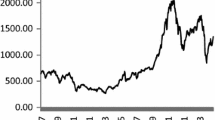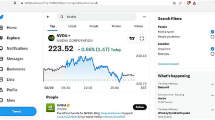Abstract
Behavioral economics has revealed that investor sentiment can profoundly affect individual behavior and decision-making. Recently, the question is no longer whether investor sentiment affects stock market valuation, but how to directly measure investor sentiment and quantify its effects. Before the era of big data, research uses proxies as a mediator to indirectly measure investor sentiment, which has proved elusive due to insufficient data points. In addition, most of extant sentiment analysis studies focus on institutional investors instead of individual investors. This is despite the fact that United States individual investors have been holding around 50% of the stock market in direct stock investments. In order to overcome difficulties in measuring sentiment and endorse the importance of individual investors, we examine the role of individual sentiment dispersion in stock market. In particular, we investigate whether sentiment dispersion contains information about future stock returns and realized volatility. Leveraging on development of big data and recent advances in data and text mining techniques, we capture 1,170,414 data points from Twitter and used a text mining method to extract sentiment and applied both linear regression and Support Vector Regression; found that individual sentiment dispersion contains information about stock realized volatility, and can be used to increase the prediction accuracy. We expect our results contribute to extant theories of electronic market financial behavior by directly measuring the individual sentiment dispersion; raising a new perspective to assess the impact of investor opinion on stock market; and recommending a supplementary investing approach using user-generated content.



Similar content being viewed by others
References
Akter, S., & Wamba, S. F. (2016). Big data analytics in E-commerce: A systematic review and agenda for future research. Electronic Markets, 26(2), 173–194.
Almgren, R. (2009). High frequency volatility. New York University.
Antweiler, W., & Frank, M. Z. (2004). Is all that talk just noise? The information content of internet stock message boards. The Journal of Finance, 59(3), 1259–1294.
Areal, N. M., & Taylor, S. J. (2002). The realized volatility of FTSE-100 futures prices. Journal of Futures Markets, 22(7), 627–648.
Baker, M., & Wurgler, J. (2006). Investor sentiment and the cross-section of stock returns. The Journal of Finance, 61(4), 1645–1680.
Barber, B. M., Odean, T., & Zhu, N. (2009a). Do retail trades move markets? Review of Financial Studies, 22(1), 151–186.
Barber, B. M., Odean, T., & Zhu, N. (2009b). Systematic noise. Journal of Financial Markets, 12(4), 547–569.
Bing, L., Chan, K. C., & Ou, C. (2014). Public sentiment analysis in twitter data for prediction of a company's stock price movements. In e-business engineering (ICEBE), 2014 I.E. 11th International Conference on (pp. 232-239). IEEE.
Black, F. (1986). Noise. The Journal of Finance, 41(3), 528–543.
Bollen, J., Mao, H., & Zeng, X. (2011). Twitter mood predicts the stock market. Journal of computational science, 2(1), 1–8.
Brown, G. W., & Cliff, M. T. (2004). Investor sentiment and the near-term stock market. Journal of Empirical Finance, 11(1), 1–27.
Carlin, B. I., Longstaff, F. A., & Matoba, K. (2014). Disagreement and asset prices. Journal of Financial Economics, 114(2), 226–238.
Chordia, T., Roll, R., & Subrahmanyam, A. (2002). Order imbalance, liquidity, and market returns. Journal of Financial Economics, 65(1), 111–130.
Corsi, F. (2005). Measuring and modelling realized volatility: From tick-by-tick to long memory (Doctoral dissertation, University of Lugano).
Da, Z., Engelberg, J., & Gao, P. (2015). The sum of all FEARS investor sentiment and asset prices. Review of Financial Studies, 28(1), 1–32.
Das, S. R., & Chen, M. Y. (2007). Yahoo! For Amazon: Sentiment extraction from small talk on the web. Management Science, 53(9), 1375–1388.
De Long, J. B., & Shleifer, A. (1991). The stock market bubble of 1929: evidence from closed-end mutual funds. The Journal of Economic History, 51(03), 675–700.
De Long, J. B., Shleifer, A., Summers, L. H., & Waldmann, R. J. (1990). Noise trader risk in financial markets. Journal of Political Economy, 703–738.
Diether, K. B., Malloy, C. J., & Scherbina, A. (2002). Differences of opinion and the cross section of stock returns. Journal of Finance, 2113–2141.
Drucker, H., Burges, C. J., Kaufman, L., Smola, A., & Vapnik, V. (1997). Support vector regression machines. Advances in neural information processing systems, 9, 155–161.
Ekbia, H., Mattioli, M., Kouper, I., Arave, G., Ghazinejad, A., Bowman, T., & Sugimoto, C. R. (2015). Big data, bigger dilemmas: A critical review. Journal of the Association for Information Science and Technology, 66(8), 1523–1545.
Fisher, K. L., & Statman, M. (2000). Cognitive biases in market forecasts. The Journal of Portfolio Management, 27(1), 72–81.
Gao, L., & Kling, G. (2008). Corporate governance and tunneling: Empirical evidence from China. Pacific-Basin Finance Journal, 16(5), 591–605.
Griffiths, T. L., & Steyvers, M. (2004). Finding scientific topics. Proceedings of the National Academy of Sciences, 101(suppl 1), 5228–5235.
Gruca, T. S., Berg, J. E., & Cipriano, M. (2005). Consensus and differences of opinion in electronic prediction markets. Electronic Markets, 15(1), 13–22.
Hornik, K., & Grün, B. (2011). Topicmodels: An R package for fitting topic models. Journal of Statistical Software, 40(13), 1–30.
Hsiao, C. (2014). Analysis of panel data, 3rd edn. Econometric Society monographs 54. Cambridge University Press.
Keynes, J. M. (1936). The general theory of employment, interest and money. London: Macmillan.
Kim, K. J. (2003). Financial time series forecasting using support vector machines. Neurocomputing, 55(1), 307–319.
Kotsiantis, S., Kanellopoulos, D., & Pintelas, P. (2006). Handling imbalanced datasets: A review. GESTS International Transactions on Computer Science and Engineering, 30(1), 25–36.
Lee, C., Shleifer, A., & Thaler, R. H. (1991). Investor sentiment and the closed-end fund puzzle. The Journal of Finance, 46(1), 75–109.
Mao, H., Counts, S., & Bollen, J. (2011). Predicting Financial Markets: Comparing Survey, News, Twitter and Search Engine Data. ArXiv E-prints, p. 10. Available from: http://arxiv.org/abs/1112.1051.
McAfee, A., & Brynjolfsson, E. (2012). Big Data: The management Revolution: Exploiting vast new flows of information can radically improve your company’s performance. But first you’ll have to change your decision making culture’[2012] Harvard Business Review.
McGraw Hill Financial (n.d.). Dow Jones Averages | About the Averages | Overview. Retrieved August 12, 2015, from https://www.djaverages.com/?go=about-overview
Miller, E. M. (1977). Risk, uncertainty, and divergence of opinion. The Journal of Finance, 32(4), 1151–1168.
Mosier, C. I. (1947). A critical examination of the concepts of face validity. Educational and Psychological Measurement, 7(2), 191–205.
Nash, M. S. (2001). Handbook of parametric and nonparametric statistical procedures. Technometrics, 43(3), 374–374.
Neal, R., & Wheatley, S. M. (1998). Do measures of investor sentiment predict returns? Journal of Financial and Quantitative Analysis, 33(04), 523–547.
Oliveira, N., Cortez, P., & Areal, N. (2013a). On the predictability of stock market behavior using stocktwits sentiment and posting volume, In Progress in Artificial Intelligence (pp. 355–365). Berlin Heidelberg: Springer.
Oliveira, N., Cortez, P., & Areal, N. (2013b). Some experiments on modeling stock market behavior using investor sentiment analysis and posting volume from twitter. In Proceedings of the 3rd International Conference on Web Intelligence, Mining and Semantics (p. 31). ACM.
Oliveira, N., Cortez, P., & Areal, N. (2014, July). Automatic creation of stock market lexicons for sentiment analysis using StockTwits data. In Proceedings of the 18th International Database Engineering & Applications Symposium (pp. 115-123). ACM.
Pedersen T, Banerjee S (2011) WordNet::Stem, Retrieved August 05, 2015, from http://search.cpan.org/~tpederse/WordNet-Similarity-2.05/lib/WordNet/stem.pm.
Poteshman, A. M. (2001). Underreaction, overreaction, and increasing misreaction to information in the options market. The Journal of Finance, 56(3), 851–876.
Qian, X. (2014). Small investor sentiment, differences of opinion and stock overvaluation. Journal of Financial Markets, 19, 219–246.
Rao, T., & Srivastava, S. (2012, August). Analyzing stock market movements using twitter sentiment analysis. In Proceedings of the 2012 International Conference on Advances in Social Networks Analysis and Mining (ASONAM 2012) (pp. 119-123). IEEE computer society.
Schmeling, M. (2009). Investor sentiment and stock returns: Some international evidence. Journal of Empirical Finance, 16(3), 394–408.
Schwert, G. W. (1998). Stock market volatility: Ten years after the crash (no. w6381). National Bureau of economic research.
Shiller, R. J. (2000). Measuring bubble expectations and investor confidence. The Journal of Psychology and Financial Markets, 1(1), 49–60.
Stoffman, N. S. (2008). Individual and institutional investor behavior. ProQuest.
Tay, F. E., & Cao, L. J. (2002). Modified support vector machines in financial time series forecasting. Neurocomputing, 48(1), 847–861.
Taylor, S. J., & Xu, X. (1997). The incremental volatility information in one million foreign exchange quotations. Journal of Empirical Finance, 4(4), 317–340.
Tetlock, P. C. (2007). Giving content to investor sentiment: The role of media in the stock market. The Journal of Finance, 62(3), 1139–1168.
Tetlock, P. C., Saar-tsechansky, M. A. Y. T. A. L., & Macskassy, S. (2008). More than words: Quantifying language to measure firms' fundamentals. The Journal of Finance, 63(3), 1437–1467.
Theil, H., & Nagar, A. L. (1961). Testing the independence of regression disturbances. Journal of the American Statistical Association, 56(296), 793–806.
Varian, H. R. (1985). Divergence of opinion in complete markets: A note. The Journal of Finance, 40(1), 309–317.
Verma, R., & Soydemir, G. (2009). The impact of individual and institutional investor sentiment on the market price of risk. The Quarterly Review of Economics and Finance, 49(3), 1129–1145.
Verma, R., & Verma, P. (2007). Noise trading and stock market volatility. Journal of Multinational Financial Management, 17(3), 231–243.
Verma, R., & Verma, P. (2008). Are survey forecasts of individual and institutional investor sentiments rational? International Review of Financial Analysis, 17(5), 1139–1155.
Wang, Y. H., Keswani, A., & Taylor, S. J. (2006). The relationships between sentiment, returns and volatility. International Journal of Forecasting, 22(1), 109–123.
Wei, Q., & Dunbrack Jr., R. L. (2013). The role of balanced training and testing data sets for binary classifiers in bioinformatics. PloS one, 8(7), e67863.
Zhang, M., Jansen, B. J., & Chowdhury, A. (2011). Business engagement on twitter: A path analysis. Electronic Markets, 21(3), 161–175.
Author information
Authors and Affiliations
Corresponding author
Additional information
Responsible Editor: Eric Ngai
Rights and permissions
About this article
Cite this article
See-To, E.W.K., Yang, Y. Market sentiment dispersion and its effects on stock return and volatility. Electron Markets 27, 283–296 (2017). https://doi.org/10.1007/s12525-017-0254-5
Received:
Accepted:
Published:
Issue Date:
DOI: https://doi.org/10.1007/s12525-017-0254-5




